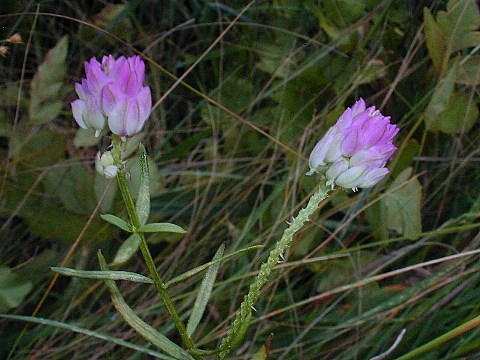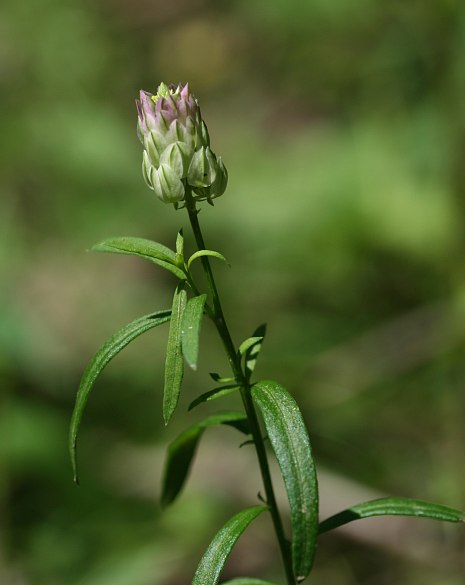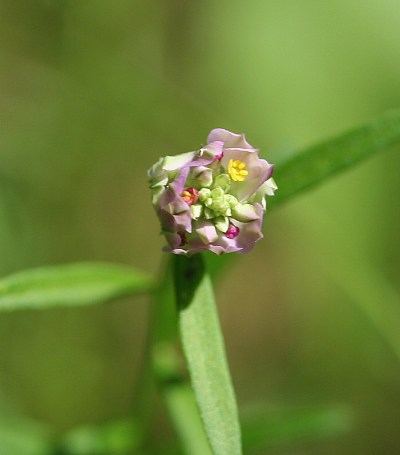Description: This annual plant is usually unbranched and 4-12" tall. The central stem is sharply angular and hairless. The alternate or opposite leaves are sessile against the stem, ranging up to 1½" in length and 1/6" (4 mm.) across. They have a prominent mid-vein, smooth margins, and are linear or oblong-linear in shape. The central stem terminates in a spike-like raceme of flowers. This raceme is about 1" long and ½" across. The outer wings of the flowers are variable in color, ranging from purplish pink, white, or green. An individual flower consists of two large sepals (i.e., the outer wings), 1 small inconspicuous sepal, and 3 small petals that form a narrow tube with 6-8 short rays. The outer wings are about 1/3" (8 mm.) long, ovate in shape, and rosy pink, pinkish white, or pinkish green. The tiny tube and rays of the petals are typically yellow, but is short-lived, typically occurring near the apex of the inflorescence, where it is partially concealed by the outer wings.

The stalk beneath the raceme has an
irregular surface and spike-like remnants of the bracts where older
flowers occurred. The blooming period is from mid-summer to early fall,
and it lasts about 1-2 months for a colony of plants. Each flower is
replaced by a capsule containing two seeds that are hairy. The root
system consists of a slender taproot that has a wintergreen fragrance.
This plant spreads by reseeding itself.
Cultivation:
The preference is full or partial sun and moist to dry conditions. Poor
soil is preferred, as this reduces competition from other plant
species. This plant often grows in soil that sandy or rocky, but will
thrive in loamy soil as well if it receives adequate sunlight.

Range &
Distribution: The native Field Milkwort occurs
occasionally
in most counties of Illinois. It is the most common Polygala
spp. (Milkwort species) in the state (see Distribution Map).
Habitats include moist
to dry prairies, sand prairies, typical savannas, sandy savannas,
woodland edges, glades, and abandoned fields. This species is
especially like to occur in areas of prairies and savannas that have
been recently disturbed.
Faunal Associations:
The nectar and pollen of the flowers attract small to medium-sized bees
and bee flies (Bombyliidae). Among the bees, are such
visitors as dagger bees (Calliopsis), long-horned bees (Melissodes),
cuckoo bees (Triepeolus), and leaf-cutting bees (Megachile).
White-tailed Deer and possibly other mammalian herbivores feed on
milkworts (Polygala spp.) sparingly (Martin et al., 1951/1961), but
they are not preferred as a source of food.
Photographic Location:
A moist sand prairie at Hooper Branch Savanna Nature Preserve in
Iroquois County, and a restored prairie at Allerton Park in Piatt
County, Illinois.

Comments: As a group, the milkworts (Polygala spp.) have not received as much attention as they deserve. Some species, such as this one, have fairly attractive flowers. They are usually found in locations with acidic sandy soil, but some species prefer dry sites with rocky material or loess. The milkworts can be distinguished from each other by taking into consideration the following: 1) whether the leaves are alternate or whorled, 2) the shape, size, and color of the wings on the flowers, 3) the density of flowers on the spike or spike-like raceme, and 4) the conspicuousness of the petals. The slender leaves of Field Milkwort are usually alternate, rather than whorled. This species has fairly large outer wings (about 1/3" or 8 mm.) that are ovate in shape and somewhat variable in color, although they are generally some shade of pink that fade to white at the base of a raceme. The density of flowers on the spike-like raceme for this milk is high, while the petals are inconspicuous. Field Milkwort has a wide distribution in the eastern United States, and different varieties have been described.